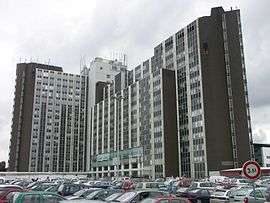Villejuif
| Villejuif | ||
|---|---|---|
|
Institut Gustave-Roussy - Main Building | ||
| ||
 Paris and inner ring departments | ||
| Coordinates: 48°47′31″N 2°21′49″E / 48.7919°N 2.3636°ECoordinates: 48°47′31″N 2°21′49″E / 48.7919°N 2.3636°E | ||
| Country | France | |
| Region | Île-de-France | |
| Department | Val-de-Marne | |
| Arrondissement | L'Haÿ-les-Roses | |
| Canton |
Villejuif-Est (Chef-lieu) Villejuif-Ouest (Chef-lieu) | |
| Intercommunality | Val de Bièvre | |
| Government | ||
| • Mayor | Franck Le Bohellec | |
| Area1 | 5.34 km2 (2.06 sq mi) | |
| Population (2008)2 | 53,240 | |
| • Density | 10,000/km2 (26,000/sq mi) | |
| Time zone | CET (UTC+1) | |
| • Summer (DST) | CEST (UTC+2) | |
| INSEE/Postal code | 94076 / 94800 | |
| Elevation | 62–130 m (203–427 ft) | |
| Website | ||
|
1 French Land Register data, which excludes lakes, ponds, glaciers > 1 km² (0.386 sq mi or 247 acres) and river estuaries. 2 Population without double counting: residents of multiple communes (e.g., students and military personnel) only counted once. | ||
Villejuif (pronounced: [vilʒɥif]) is a commune in the southern suburbs of Paris, France. It is located 7 km (4.3 mi) from the centre of Paris.
Name
The name Villejuif can be imprecisely translated as "Jewish Town", but the area has no historical connections with the Jewish population of Paris. The name is believed to be a corruption of a Gallo-Roman name, Villa Iuvii, meaning the villa of Iuvius.[1]
Demographics
Population
| Historical population | ||
|---|---|---|
| Year | Pop. | ±% |
| 1793 | 1,362 | — |
| 1800 | 1,137 | −16.5% |
| 1806 | 1,320 | +16.1% |
| 1821 | 1,278 | −3.2% |
| 1831 | 1,377 | +7.7% |
| 1836 | 1,652 | +20.0% |
| 1841 | 1,503 | −9.0% |
| 1846 | 1,587 | +5.6% |
| 1851 | 1,514 | −4.6% |
| 1856 | 1,559 | +3.0% |
| 1861 | 1,813 | +16.3% |
| 1866 | 2,308 | +27.3% |
| 1872 | 1,917 | −16.9% |
| 1876 | 2,117 | +10.4% |
| 1881 | 2,678 | +26.5% |
| 1886 | 3,163 | +18.1% |
| 1891 | 4,294 | +35.8% |
| 1896 | 5,234 | +21.9% |
| 1901 | 5,835 | +11.5% |
| 1906 | 6,600 | +13.1% |
| 1911 | 8,671 | +31.4% |
| 1921 | 11,725 | +35.2% |
| 1926 | 18,751 | +59.9% |
| 1931 | 25,192 | +34.4% |
| 1936 | 27,540 | +9.3% |
| 1946 | 25,359 | −7.9% |
| 1954 | 29,280 | +15.5% |
| 1962 | 46,116 | +57.5% |
| 1968 | 51,120 | +10.9% |
| 1975 | 55,606 | +8.8% |
| 1982 | 52,448 | −5.7% |
| 1990 | 48,405 | −7.7% |
| 1999 | 47,384 | −2.1% |
| 2006 | 51,739 | +9.2% |
Immigration
| |||||||||||||||||||
Transport
Villejuif is served by three stations on Paris Métro Line 7: Villejuif – Léo Lagrange, Villejuif – Paul Vaillant-Couturier, and Villejuif – Louis Aragon.
Personalities
- Camille Loiseau, the Doyenne de France from 26 March 2005 to 12 August 2006, died at the Hôpital Paul-Brousse in Villejuif.
- Issei Sagawa, the Japanese killer and cannibal, was an inmate at high-security Paul Guiraud hospital in Villejuif, in 1982–1984.
- Komitas Vardapet, the founder of modern Armenian classical music.
- Vladimir Ghika, Catholic parish priest from 1923-1930, killed in Romania in 1954, beatified 31 August 2013.
Hospitals
Villejuif has many hospitals on its territory :
- the Institut Gustave Roussy, leading hospital in oncology in Europe
- the Hôpital Paul-Brousse
- the Paul Guiraud hospital
Education
13 preschools, 11 elementary schools, and five junior high schools (Collège Aimé-Césaire, Collège Guy-Môquet, Collège Jean Lurçat, Collège Karl-Marx, Collège Pasteur) are in Villejuif. Lycée intercommunal Darius-Milhaud (in Le Kremlin-Bicêtre) serves Villejuif.[2]
Other institutions:
Twin cities
 Dunaújváros, Hungary
Dunaújváros, Hungary Mirandola, Italy
Mirandola, Italy Neubrandenburg, Germany
Neubrandenburg, Germany Vila Franca de Xira, Portugal
Vila Franca de Xira, Portugal Yambol, Bulgaria
Yambol, Bulgaria
See also
References
- INSEE
- Mayors of Essonne Association (French)
- ↑ Pierre Hentgès, "Note sur la signification de Villejuif", in Villejuif, notre cité, 1975, p. 235-238
- ↑ "Etablissements scolaires." Villejuif. Retrieved on June 23, 2015.
External links
| Wikimedia Commons has media related to Villejuif. |

